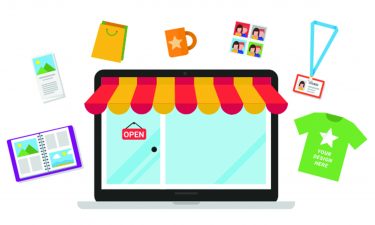Over the past year, lockdowns and the rise of online shopping have given web-to-print platforms a chance to really prove their worth, moving from ‘nice to have’ extras to business essentials. There are now several ways to implement it, too
Early web-to-print software was sold it on the premise ‘build it and they will come’, encouraging printers to think that all they to do was open the online shop and flocks of customers would beat a path to their door. Of course that largely didn’t work, as sites need to be both promoted among the noise of the internet and connected to something at the printer’s side.
The production issues have largely been addressed now, though e-commerce sites still need promotion, and the past 12 months in particular have really demonstrated how vital having an e-commerce offering can be, as customers get ever more comfortable using the internet to shop.
A recent report from online print service Cloudprinter suggests that online print companies have actually managed to increase their productivity and efficiency since the start of the pandemic. The company says that it processed around 1.3 million orders between March 2020 and January 2021 from which it randomly selected 65,000 in order to analyse trends and better understand the market.
The report, Global Printing During Covid-19, found that the e-commerce sector in the US saw as much growth in three months of quarantine as it would normally expect in 10 years, with online delivery volume increasing by the same amount in eight weeks as it had over the entire previous decade. The report stresses the ‘Amazonisation’ of the sector and demand for tracked deliveries. It also highlighted how the key difference between companies that have struggled and thrived is that the latter have implemented improvements that increase their efficiency and allow them to serve more customers and process more orders.
Vpress sales director Kelvin Bell puts it more forcefully: ‘Printers need to fundamentally understand that e-commerce is now their shop front, their sales team, marketing engine, automated account management system and revenue generation platform all rolled into one.’
One of the most useful developments in web-to-print is just how much easier it has become to have a print portal. There are two main routes: join a print aggregator site that connects printers with customers, either behind a service brand façade, or explicitly, or to use an e-commerce setup service that uses off-the-shelf technology components but allows tailored configuration and branding options
Cloudprinter is one example of the former category, and another more recent addition is Nettl. Peter Gunning, CEO of Grafenia, has a long track record with web-to-print, having opened the first printing.com store in Edinburgh in 1998. More recently, he set up the Nettl network of print and marketing service providers. He observes, ‘Years’ worth of change has taken place overnight. Clients have different priorities and businesses that were able to adapt and provide what clients wanted have done better than most.’
‘E-commerce has been one of the clear big winners and online retailers have had a bonanza. Many consumers tried online shopping for the first time, and they liked it – instant gratification is here to stay.’
Stung into action
Consequently, he has opened up the Nettl to third-party manufacturers. This brings independent product manufacturers, dubbed Works Makers, into contact with potential customers. Mr Gunning says, ‘We’ve added hundreds of new product categories and dozens of independent makers supplying clients across the land. So, if you manufacture packaging, labels, apparel, promo give-aways, branded gifts, custom furniture or anything else that a company might use for marketing, we want it on our platform.’

Cloud to Print offers ‘off-the-shelf bespoke’ e-commerce sites based on Vpress Coreprint
An example of the ‘building blocks’ approach is Making Websites Better, a print-focused website and marketing agency that has partnered with Vpress to launch Cloud to Print, using the latter’s Coreprint W2P engine to configure, build and (shortly) promote complete e-commerce sites at very competitive fixed prices, using pre-built modules such as help centres, file handling tools, blogs and product galleries.
Founder Paul Warren says the Cloud to Print service offers ‘candid and helpful’ advice about how the e-commerce sites should be structured and presented, noting that ‘printers often need hand-holding’. He suggested that the more tightly focused or specialist a printer is, the better the service will work, as potential customers can be more precisely targeted.’
Another supplier that aims to take the technical pain out of site building and commissioning is Aurigma, whose Customer’s Canvas builds sales sites on the Shopify e-commerce platform. Customer’s Canvas cover the development cycle, from defining project goals and outcome, through building a proof-of-concept to check feasibility, followed by training, and ongoing support, It uses its own technology, principally a web-to-print editor and a new back office component that simplifies integration.
‘We decided to offer a service for Shopify-based storefronts because this e-commerce platform is easy to set up and use, yet powerful,’ said CEO Dmitry Sevostyanov. ‘Much like our service, Shopify helps users focus on their core business and gets rid of the headache of setup and maintenance.’
A choice of e-commerce platform is now offered by CloudLab, in the latest revision of its PrintQ W2P software, with Adobe Magento 2 being the default but Shopify also an option. Now handled in the UK by Transeo Media, printQ users include some heavy hitters such as Cimpress, Flyeralarm and Saxoprint, and now contains tools for packaging design and 3D preview.
Transeo managing director Neil Bather says, ‘PrintQ isn’t an off-the-shelf package, which don’t always have the necessary flexibility and don’t always offer the best in terms of SEO. What we are offering is a modern architecture, a W2P system sat on a modern e-commerce platform.’ It does come with editable templates, though, and uses AI to handle ‘80 or 90% of the work,’ he says.
Making the case
A more ‘traditional’ approach to W2P is exemplified by Infigo software, one of whose customers is Personalised Luggage, which markets itself as the UK’s first and only manufacturer and distributor of fully personalised suitcases. Initially targeting the corporate gifts sector, Personalised Luggage soon realised there was wider demand from retail and drop-shipping customers.

Customer’s Canvas says its service takes care of the technical aspects of building a W2P store
Via an implementation of Infigo’s software, the company can now offer one-off designs at a similar cost to larger runs, enabling it to target individual customers as well as providing white-label production services for e-commerce partners. Managing director Stephen Isaacs comments, ‘It’s just made the production process a lot more seamless. The various integrations that are possible with Infigo’s partners – from MIS providers to shipping couriers – have been invaluable, creating a cohesive workflow from order to dispatch.’
Personalised Luggage’s factory is in Leeds, but integration with shipping providers gives the company a global reach. ‘We can distribute our products all over the world and use a range of delivery partners dependent on location to offer the quickest possible turnaround,’ explains Mr Isaacs.
Integration was also critical for a Vpress installation at central London-based MJCP, where it was key to winning a big care home client for the multi-print services provider. The combination of Vpress W2P with the Time Harvest MIS allows correctly-branded materials to be ordered for more than 300 locations.
‘Their staff can now just log in, specify and personalise the products they want and go. It has made a big difference to their operation. All that variable data is no longer an arduous time-heavy job to process, they now have an extremely user-friendly interface that goes straight through to our production lines,’ notes MJCP operations director Ray Barber.
‘Where Vpress and Time Harvest help is they have allowed us to streamline the businesses, automate a lot more of our systems, and enable us to be competitive at speed – which is critical – especially in today’s environment.
‘Without that presence online backed up by solid back office systems, you don’t capture that next generation of customers. Having a web presence and having that shop front available, with excellent service behind it, is absolutely critical,’ he concludes.
That’s sound advice for any printer these days. With people being more used than ever to ordering things easily online – and getting them quickly – it’s not so much a case of ‘build it and they will come’, perhaps, as one of ‘if you don’t build it, they won’t bother to find you any other way’. The good news is that it has never been so easy to do.





